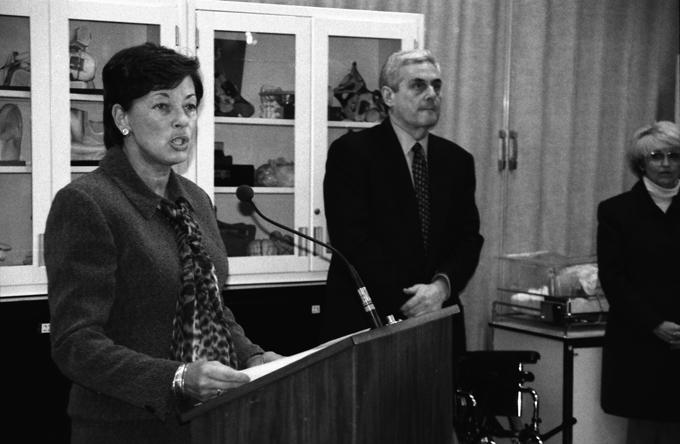By Tamsin McMahon
Ontario nurses are about to get some critical care.
The province is giving nursing a $20 million boost, Ontario Health Minister Elizabeth Witmer announced Monday at Ryerson.
The sum is part of a planned $375 million investment in Ontario’s health care system. The minister announced an additional $45 million on Tuesday to hire 650 nurses in community care and therapy.
“We are moving forward towards a goal of bringing greater stability towards a goal of bringing greater stability and certainty to the nursing profession,” Witmer told a classroom crowded with people on the fourth floor of Jorgenson Hall.
Monday’s announcement gave $10 million a year to create 106 new jobs for nurse practitioners — registered nurses who have taken extra training can diagnose some illnesses and prescribe treatments — and $10 million a year for eduction and training.
This is good news for Jill Quance, one of almost 1,300 students in Ryerson’s undergraduate and graduate nursing programs.
Quance, 34, has been a nurse for 14 years and recently took a year off from her job at the Toronto Hospital to take Ryerson’s year-long nurse practitioner program in hopes of finding a new job.
She said the province’s commitment to hire more nurses is a step in the right direction. “It’s a good start,” she said.
Monday’s press conference was the first in a series of announcements this week outlining the province’s response to the Nursing Task Force, which recommended in February that the province invest $375 million in nursing services by 2000. This includes $125 million for permanent nursing jobs before April.
The task force said the province should restore the work force to the national average of one nurse for every 132 people, meaning the government must create more than 10,000 nursing positions in Ontario.
RyeSAC’s v.p. education and president-elect Erin George briefly interrupted Monday’s press conference to accuse the Conservative government of being hypocritical for creating the positions after nursing jobs were cut.
“How can you justify the hypocrisy of your government, using nursing students for your pre-election photo op?” George said before being overcome with tears.
Ontario nurses were the hardest hit when the when the provincial government announced it would skim 18 per cent from its he alt care budget in 1996. More than 8,000 nursing jobs were cut, leaving Ontario with only one nurse for every 145 people.
Some, like Barb Wahl, president of the Ontario Nurses Association, are skeptical the province’s plans to hire more nurses will give the professors much-needed job security.
“A lot of nurses are not going to come back,” she said. “They have been forced out and they have found other opportunities and unless they are ensured of some security in the nursing world, they won’t come back.”
Some nurses have gone to the U.S. to find work. Others have settled for casual jobs or short-term contracts for lack of full-time positions.
Nancy Kwan is one of them. The Ryerson post-registered nursing student is working in a casual position, which means her hours aren’t guaranteed. “But two years ago you couldn’t even get a casual position,” said the registered nurse and George Brown graduate.
Kwan said the province’s initiatives aren’t drastic measures. “It’s just bringing [the number of jobs] up to the standard it was two to three years ago.”
Either way, Silvana Dasilva, a first-year post-registered nursing student at Ryerson, said she may go to the United States for work. “Frankly, I don’t know what’s going to happen to me and nursing.”
She said she has already sent more than 1,000 resumes to hospitals in Canada, but only got a few interviews.
Dasilva, who works at the recently amalgamated Toronto Rehabilitation Institute, said she can see the effects of nursing shortages on the job.
“Even at my floor all the nurses are very tense,” she said. “I wish I knew more of this when I went into nursing in the first place.”











Leave a Reply